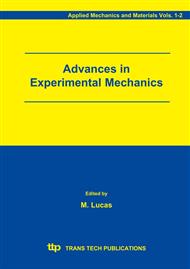p.45
p.51
p.59
p.65
p.71
p.81
p.87
p.93
p.99
The Design and Analysis of a New Type of Vibration Structure
Abstract:
In this paper, a new type of vibration structure (i.e. swing frame) of vertical dynamic balancing machine is designed, which is based on the analysis of traditional double-plane vertical dynamic balancing machine’s swing frame. The static unbalance and couple unbalance can be separated effectively by using the new dynamic balancing machine with the new swing frame. The modal and harmonic responses are analyzed by using the ANSYS7.0. By comparing the finite element modal analysis with the experimental modal analysis, the natural frequencies and vibration modes are found out, which can provide the dynamics direction for designing vertical dynamic balancing machine. The new dynamic balancing machine can measure static unbalance and couple unbalance directly, and the influence between them is faint. The practical result indicates that the new vertical dynamic balancing machine is suitable for inertial measurement of flying objects, and can overcome the shortcomings of traditional double-plane vertical dynamic balancing machines, in which the effect of plane-separation is inferior. The vertical dynamic balancing machine with the new vibration structure can be widely used in the future application.
Info:
Periodical:
Pages:
71-80
Citation:
Online since:
September 2004
Authors:
Price:
Сopyright:
© 2004 Trans Tech Publications Ltd. All Rights Reserved
Share:
Citation:


